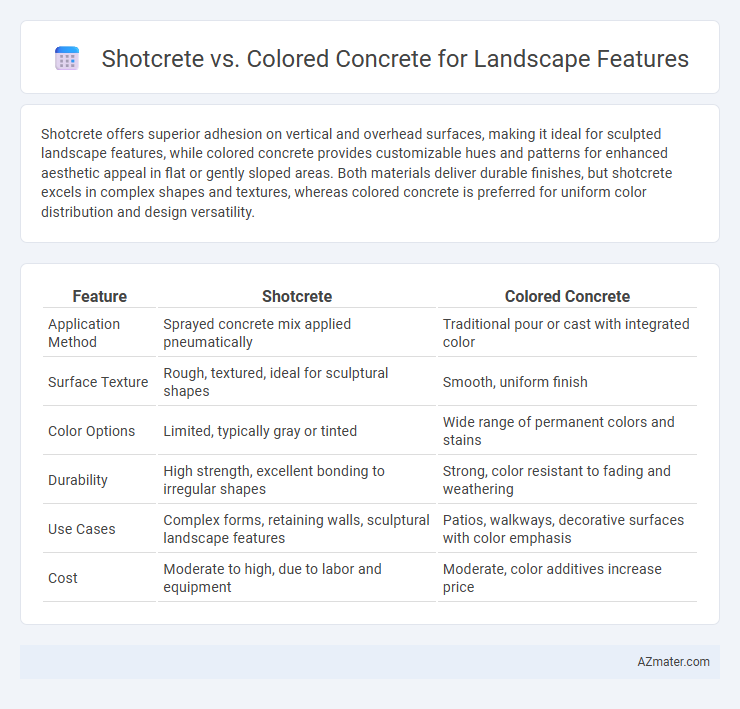Shotcrete offers superior adhesion on vertical and overhead surfaces, making it ideal for sculpted landscape features, while colored concrete provides customizable hues and patterns for enhanced aesthetic appeal in flat or gently sloped areas. Both materials deliver durable finishes, but shotcrete excels in complex shapes and textures, whereas colored concrete is preferred for uniform color distribution and design versatility.
Table of Comparison
| Feature | Shotcrete | Colored Concrete |
|---|---|---|
| Application Method | Sprayed concrete mix applied pneumatically | Traditional pour or cast with integrated color |
| Surface Texture | Rough, textured, ideal for sculptural shapes | Smooth, uniform finish |
| Color Options | Limited, typically gray or tinted | Wide range of permanent colors and stains |
| Durability | High strength, excellent bonding to irregular shapes | Strong, color resistant to fading and weathering |
| Use Cases | Complex forms, retaining walls, sculptural landscape features | Patios, walkways, decorative surfaces with color emphasis |
| Cost | Moderate to high, due to labor and equipment | Moderate, color additives increase price |
Introduction to Shotcrete and Colored Concrete
Shotcrete is a dense, high-strength concrete sprayed through a nozzle at high velocity, providing superior adhesion and durability for complex landscape features like retaining walls and sculpted elements. Colored concrete incorporates mineral pigments mixed directly into the concrete, allowing for vibrant, long-lasting hues that enhance aesthetic appeal in pathways, patios, and decorative structures. Both materials offer unique advantages: shotcrete excels in structural integrity and shaping flexibility, while colored concrete prioritizes visual customization and design variety for outdoor environments.
Key Differences Between Shotcrete and Colored Concrete
Shotcrete is a method of spraying concrete at high velocity onto surfaces, ideal for complex shapes and rapid application, whereas colored concrete involves adding pigments directly into the mix to achieve uniform coloration throughout the material. Shotcrete offers superior structural strength and adhesion, making it suitable for retaining walls and sculptural elements, while colored concrete emphasizes aesthetic appeal with consistent, customizable hues for patios and pathways. Key differences lie in application technique, strength properties, and visual customization, impacting their use in landscape features based on project requirements.
Advantages of Using Shotcrete for Landscape Features
Shotcrete offers superior adhesion and flexibility, making it ideal for complex landscape features such as retaining walls and curved surfaces. Its high compressive strength and durability ensure long-lasting structures that resist cracking and weathering. Additionally, the ability to apply shotcrete without forms reduces construction time and costs while allowing for intricate, custom designs in outdoor settings.
Benefits of Colored Concrete in Landscaping
Colored concrete enhances landscape features by providing long-lasting, vibrant hues that resist fading from UV exposure and weather conditions. Its versatility allows for customizable designs and patterns, creating visually appealing outdoor spaces with minimal maintenance. The durable nature of colored concrete reduces the need for frequent repairs, offering a cost-effective solution for complex landscape applications.
Durability and Longevity Comparison
Shotcrete offers superior durability and longevity for landscape features due to its high-density application and strong adhesion properties, which resist weathering, erosion, and cracking better than colored concrete. Colored concrete, while visually appealing, can be prone to surface wear and fading over time, especially in harsh environmental conditions, reducing its lifespan compared to shotcrete. The enhanced strength and resilience of shotcrete make it a preferable choice for long-term landscape installations requiring minimal maintenance.
Aesthetic Options: Textures and Color Variations
Shotcrete offers diverse textures through spraying techniques, enabling rough, smooth, or sculpted finishes that enhance landscape features with natural, rugged appearances. Colored concrete provides extensive color variations with integral pigments, stains, or dyes, allowing precise customization to match design themes and complement surrounding environments. Combining both methods can create visually striking landscapes, blending textured surfaces with vibrant, durable color options.
Installation Process: Shotcrete vs Colored Concrete
The installation process of shotcrete involves spraying a high-velocity mixture of cement, sand, and water directly onto surfaces, allowing for rapid setting and strong adhesion, ideal for complex or vertical landscape features. Colored concrete is produced by mixing pigments directly into the concrete batch before pouring, requiring precise batching and curing to achieve consistent coloration and finish, typically used for flat or large surface areas. Shotcrete offers flexibility and speed for custom shapes, while colored concrete demands careful preparation for uniform color and texture in landscape installations.
Cost Analysis and Budget Considerations
Shotcrete offers cost savings in landscape features due to reduced labor and faster application compared to traditional colored concrete, which requires more time for mixing and finishing. Colored concrete often incurs higher material costs from pigments and sealers, making it pricier but providing enhanced aesthetic customization for projects with specific design requirements. Budget considerations should weigh the balance between initial installation costs and long-term maintenance expenses, as shotcrete can be more economical upfront while colored concrete may add value through visual appeal.
Maintenance Requirements for Each Material
Shotcrete requires less frequent sealing and resists cracking due to its dense application method, reducing long-term maintenance efforts in landscape features. Colored concrete often needs periodic resealing to maintain vibrant hues and prevent fading from UV exposure, which increases upkeep requirements. Both materials benefit from routine cleaning, but shotcrete's durability typically results in lower overall maintenance costs compared to colored concrete.
Choosing the Right Option for Your Landscape Project
Shotcrete offers superior strength and versatility, making it ideal for complex landscape features such as retaining walls and sculptural elements requiring high durability. Colored concrete provides aesthetic customization with vibrant hues and uniform coloring, perfect for patios, walkways, and decorative surfaces where visual appeal is paramount. Selecting the right option depends on balancing structural requirements with design preferences, project budget, and maintenance considerations to achieve lasting performance and beauty.

Infographic: Shotcrete vs Colored Concrete for Landscape Feature
 azmater.com
azmater.com